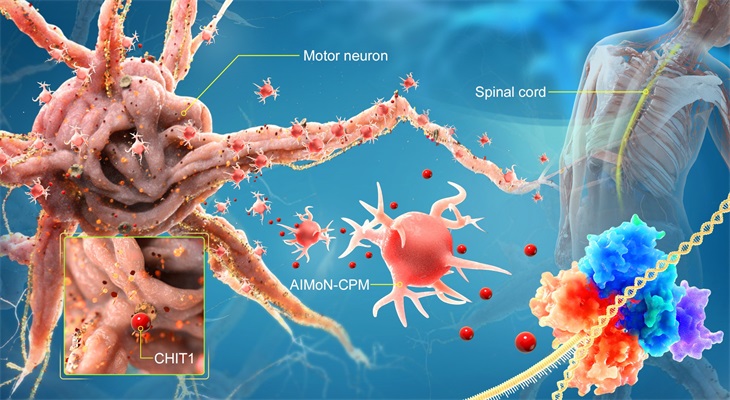Chinese scholars have made progress in deciphering the driving force of aging in the primate spinal cord
Source:Shuhui Sun
2024-02-03
The research group led by Prof. Guang-Hui Liu and Prof. Jing Qu from the Institute of Zoology of the Chinese Academy of Sciences, together with Prof. Weiqi Zhang’s research team from the Beijing Institute of Genomics of the Chinese Academy of Sciences, have made progress in revealing the molecular mechanism of aging in the primate spinal cord. Their study, titled “CHIT1-positive microglia drive motor neuron aging in the primate spinal cord”, published online in Nature on October 31, 2023, unveiled a previously unknown subtype of CHIT1-positive microglia in the aged spinal cord of non-human primates. These cells play a driving role in motor neuron aging by activating SMAD signaling through the secretion of the CHIT1 protein.
The spinal cord, a vital bridge connecting the brain and peripheral nerves, plays a pivotal role in governing motor functions and coordinating basic life activities. As the "command center" for human movement and basic organ autonomous activities, the aging process of the spinal cord may serve as the foundation for the coexistence of various chronic diseases in the elderly population. However, the mechanisms of spinal cord aging remain poorly understood.
The research team identified a previously unknown subtype of microglia, named as AIMoN-CPM (aging-induced motor neuron toxic CHIT1-positive microglia), which are specifically found in the spinal cords of aged primates. AIMoN-CPM were frequently observed to accumulate around senescent motor neurons, exerting toxic effects on their motor neuron neighbors through the action of CHIT1. The secretion of CHIT1 can activate the SMAD signaling pathway in motor neurons, thereby driving their aging process. Interestingly, further investigations revealed elevated levels of CHIT1 in the cerebrospinal fluid and serum of both aged humans and monkeys. These findings suggest that CHIT1 could serve as a biomarker for spinal cord aging in primates. Additionally, the study found that vitamin C effectively inhibited CHIT1-induced aging of motor neurons, and vitamin C supplementation delayed the aging and degeneration of spinal motor neurons (Figure).

This study provides the first systematic characterization of the phenotypic, pathological, cellular and molecular features of primate spinal cord aging. It unveils the existence of AIMoN-CPM, a microglial cell subtype that drives motor neuron aging. The study also identifies CHIT1 as a potential humoral marker for measuring the degree of spinal cord aging in humans. Moreover, it offers a potential target for delaying motor neuron aging. These findings present new avenues for deferring spinal cord aging and actively preventing and controlling age-related comorbidities.
This study was supported by the National Key Research and Development Program of China, National Natural Science Foundation of China and other funding sources.
Article link: https://www.nature.com/articles/s41586-023-06783-1
The spinal cord, a vital bridge connecting the brain and peripheral nerves, plays a pivotal role in governing motor functions and coordinating basic life activities. As the "command center" for human movement and basic organ autonomous activities, the aging process of the spinal cord may serve as the foundation for the coexistence of various chronic diseases in the elderly population. However, the mechanisms of spinal cord aging remain poorly understood.
The research team identified a previously unknown subtype of microglia, named as AIMoN-CPM (aging-induced motor neuron toxic CHIT1-positive microglia), which are specifically found in the spinal cords of aged primates. AIMoN-CPM were frequently observed to accumulate around senescent motor neurons, exerting toxic effects on their motor neuron neighbors through the action of CHIT1. The secretion of CHIT1 can activate the SMAD signaling pathway in motor neurons, thereby driving their aging process. Interestingly, further investigations revealed elevated levels of CHIT1 in the cerebrospinal fluid and serum of both aged humans and monkeys. These findings suggest that CHIT1 could serve as a biomarker for spinal cord aging in primates. Additionally, the study found that vitamin C effectively inhibited CHIT1-induced aging of motor neurons, and vitamin C supplementation delayed the aging and degeneration of spinal motor neurons (Figure).

Figure. AIMoN-CPM drive motor neuron aging through CHIT1 in a paracrine signaling manner
This study provides the first systematic characterization of the phenotypic, pathological, cellular and molecular features of primate spinal cord aging. It unveils the existence of AIMoN-CPM, a microglial cell subtype that drives motor neuron aging. The study also identifies CHIT1 as a potential humoral marker for measuring the degree of spinal cord aging in humans. Moreover, it offers a potential target for delaying motor neuron aging. These findings present new avenues for deferring spinal cord aging and actively preventing and controlling age-related comorbidities.
This study was supported by the National Key Research and Development Program of China, National Natural Science Foundation of China and other funding sources.
Article link: https://www.nature.com/articles/s41586-023-06783-1


